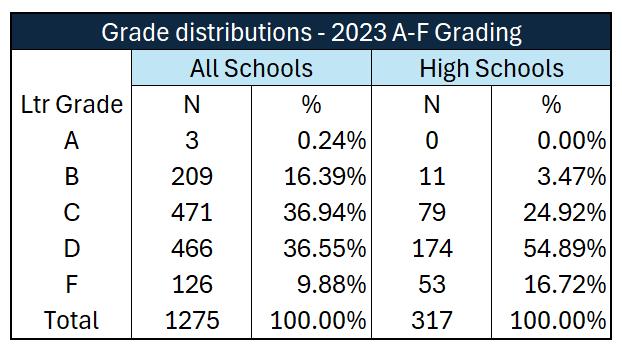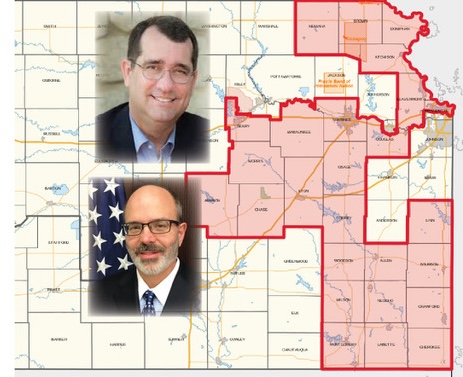WICHITA – A conservative policy organization that monitors student achievement in Kansas has published an A-F grading summary of public and private schools across the state based on state assessment tests administered by the Kansas State Department of Education, and the synopsis of measured data shows Kansas schools by and large continue to struggle to adequately educate kids.
In the report “A-F Grading Kansas Schools,” author David Dorsey says the 2023 report summarizes school performance ratings for parents who may be opting for alternatives for their kids as “the public education landscape continues to change.”

“This phenomenon was exacerbated by unwarranted school closures as a response to COVID-19,” Dorsey with the Kansas Policy Institute says. “People are hungry for a change, especially those who feel stuck in underperforming schools. But the question is, where does one go to find out how a school in the state is actually performing?”
Dorsey says the online report provides a a ‘one-stop’ destination to find out how many of Kansas’ roughly 1,300 public and many private schools are faring in a simple to understand format.
“This is something you cannot get through KSDE,” Dorsey says. “Despite the fact that the Feds prescribe KSDE to publish a ‘report card’, the factors that make up that report card are scattered about KSDE’s website. More importantly, there is no letter grading system that provides a summary of any particular school. KPI has taken the initiative to letter-grade schools. And it’s all right here.”
Dorsey said the assignment of A-F grades is important because it reveals the real state of performance of Kansas schools. While the State Board of Education and KSDE leads the public to believe that “Kansas leads the world in the success of each student,” Dorsey says the KPI presentation and analysis of state-produced data tells a much different story regarding student achievement.
The 2023 edition includes grades for 1,275 total public and private schools, based on the most recently available state assessments. A total of 1,275 public and private schools received grades for 2023 based on the schools that take the state assessment: a few schools that do take the exam had to be excluded because of data limitations and privacy concerns. The distribution is reflected in the table below. Only three schools received an overall grade of “A” – all three are elementary schools. Two are public schools, Timber Creek Elementary School and Mission Trail Elementary School, both in the Blue Valley (USD 229) district. The other school that earned an “A” is St. Patrick Catholic Elementary School in Parsons. Roughly one in six elementary schools received a “B.”

High schools in Kansas continue to struggle. No high schools received an overall grade of “A”, while 11 earned a “B.” More than half of all high schools earned a “D.” Overall, the grades changed little from 2022. The biggest difference is that in 2023 the percentage of schools earning a grade of “F” nearly doubled.
KPI started the review and grading system of the state-gathered data in 2017 and has published the grades ever since, except in 2020 when Governor Kelly shut down the schools during the pandemic and tests weren’t administered.
The Kansas State Department of Education (KSDE) publishes a “Report Card” on its website, but Dorsey said one must navigate through a myriad of indicators, and there is no grade-based summary for each school.
“KSDE employs such benign terms as ‘limited’, ‘basic’, ‘effective’, and ‘excellent’ to describe a student’s state assessment scores,” Dorsey said, “but what does that really mean”?

KPI takes those state assessment results reported by KSDE and translates raw scores (which range from 220 to 380 for math and for English language arts – ELA) into letter grades. (A full methodology outline, data, and definitions is available on the A-F Grading home page.) This process gives a more concrete explanation of those results.
A-F grading on the website contains an abundance of data in addition to a school’s overall letter grade. Included are: a pin mapping system that shows the location of each school, contact information, enrollment, per-pupil spending, grade-level grades for both low-income and other students, % of low-income students and proficiency rates for both math and English language arts (ELA).
Dorsey said this reporting system continues to provide opportunities to explore questions surrounding the issue of school performance.
“Why do some schools continue to out-perform others?,” Dorsey asked. “Why does the education establishment continue to lobby for more money when it is clear from this data that spending and school performance are not related?”
A printed version of the report is available by emailing information@kansaspolicy.org
Dane Hicks is a graduate of the University of Missouri School of Journalism and the United States Marine Corps Officer Candidate School at Quantico, VA. He is the author of novels "The Skinning Tree" and "A Whisper For Help." As publisher of the Anderson County Review in Garnett, KS., he is a recipient of the Kansas Press Association's Boyd Community Service Award as well as more than 60 awards for excellence in news, editorial and photography.





